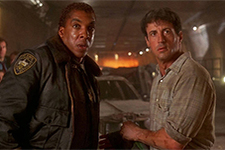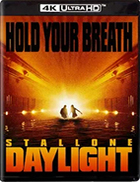Daylight (4K UHD)
|  As film scholar Maurice Yacowar noted in his oft-reprinted 1977 essay “The Bug in the Rug: Notes on the Disaster Film,” disaster films have been around for as long as there have been filmmakers imagining creative ways for horrible events to strike hapless characters—that is to say, since the beginning. He notes films as old as Georges Mèliés’s Collision and Shipwreck at Sea (1898), The Eruption of Mount Pelee (1902), and The Catastrophe of the Balloon “Le Pax” (1902) as notable examples. Thus, when the mid-1990s erupted in a new cycle of disaster movies, it was not so much a return to the early 1970s—when the box office was often dominated by doomed planes, overturned cruise liners, and burning skyscrapers—as it was an extension of a genre that had always been. In his essay, Yacowar recounts the various types of disaster films, which range from natural attacks, to travel disasters, to monster attacks, all of which have in common the fundamental “essence of the genre: a situation of normalcy erupts into a persuasive image of death.”And that is precisely what Rob Cohen’s Daylight gives us. Released at the end of the same year that gave us Jan De Bont’s Twister (1996) and Roland Emmerich and Dean Devlin’s Independence Day (1996) and arriving the year before the dueling volcano movies, Dante’s Peak (1997) and Volcano (1997), and James Cameron’s romantic blockbuster Titanic (1997), Daylight was one of Sylvester Stallone’s last attempts to hold onto his action movie mantle following a series of box-office disappointments: Demolition Man (1993), The Specialist (1994), and the double punch of Judge Dredd (1995) and Assassins (1995). Alas, it didn’t work out, as Daylight only pulled in about $33 million in the U.S. against a budget of $80 million (it did make an additional $126 million overseas, but that still hardly qualified it as a hit). It is too bad it underperformed because Daylight is a better movie than its box office suggests, although it certainly falls short of Stallone’s best work in the action genre, especially Renny Harlin’s Cliffhanger (1993). Daylight is a particularly apt example of the disaster movie Yacowar calls “The City Fails,” in which “man is most dramatically punished for placing faith in his works and losing sight of his maker. So his edifices crumble around him.” In this case, the edifice—a miles-long underwater tunnel connecting Manhattan and New Jersey—explodes and floods. Disaster strikes when a car full of thieves trying to outrun the police collide with several trucks carrying barrels of flammable toxic waste, which explode in grandiose fashion, setting off a furious chain reaction of disasters that finds multiple cars crashing and burning and huge sections of the tunnel collapsing as a massive fireball rolls through it, sealing off both ends and trapping in the middle a small group of survivors who will quicky either run out of air or drown once water from the Hudson River begins seeping in. Unlike the ’70s disaster movies, which tended to assemble a wide range of stars both past and present, Stallone is the only name above the marquee here, with all the other characters played by generally recognizable character actors like Amy Brenneman (soon-to-be star of the TV series Judging Amy), who plays a frustrated playwright who was leaving New York when she gets trapped, and Dan Hedaya as head of the emergency response team. A pre-Lord of the Rings Viggo Mortensen plays the adrenaline-junkie CEO of an athletic shoe company who is just itching to save the day with his misplaced bravado, and Stan Shaw, a 20-year veteran of film and television who got his start in blaxploitation films, plays a well-meaning police officer assigned to duty in the tunnel. Thus, no one is in danger of upstaging Stallone’s ridiculously named Kit Latura, who at first appears to be an amiable taxi driver, but turns out to be the (unfairly) disgraced former chief of New York Emergency Medical Services. Kit, like many such heroes, is in possession of crucial information about the tunnel, having run terrorism-related exercises in it two years earlier, but of course no one wants to listen, which is why he takes it upon himself to join the trapped survivors and try to help them get to safety. Things quickly go from bad to worse, as in-fighting among the survivors (which includes a group of prisoners being transported to jail, one of whom is played by Stallone’s son Sage) poses as much of a threat as the rising water and depleting oxygen. Daylight was written by Leslie Bohem, who had previously penned the Jean-Claude Van Damme action vehicle Nowhere to Run (1993) and would later write Dante’s Peak and co-write John Lee Hancock’s The Alamo (2004), as well as the miniseries Taken (2002) and Extant (2014). The script provides all the expected genre twists and turns, but there aren’t really any surprises (even the drawn-out drama over Kit’s tragic background feels underwhelming and obvious once it is revealed). The real power in the film comes from director Rob Cohen, who had spent a decade producing and directing television before moving into feature films with the biopic Dragon: The Bruce Lee Story (1993) and fantasy film Dragonheart (1996). With Daylight Cohen found his true calling, which is in that tight space between the audacious and the ridiculous. He supplies plenty of bombast when the disaster strikes (the initial explosion in the tunnel is particularly spectacular), although things feel sluggish when characters talk too much. He doesn’t fully embrace the ludicrous as he would later when he gave us Vin Diesel snowboarding down an exploding mountain in xXx (2003) and thieves trying to outrun dangerous weather in The Hurricane Heist (2018), but he comes awful close.
Copyright © 2025 James Kendrick Thoughts? E-mail James Kendrick All images copyright © Kino Lorber | |||||||||||||||||||||||||||||
Overall Rating: 

 (2.5)
(2.5)


